Europe Divided, the strategic, modern history board game of politics, influence, and tactical conflict published by PHALANX Games and designed by David Thompson and Chris Marling is now reaching stores. The game was successfully funded in mid-2019 on Kickstarter, and at that time Thompson shared its story on BoardGameGeek in a Designer’s Diary, with occasional inputs from his design partner Marling. Now we repost it as a great source for more information about the game.
“The threat of world war is no more.” - Soviet Premier Mikhail Gorbachev
"The end of the Cold War ushered in a new age of European expansion. Central and Eastern Europe had emerged from dictatorships and wanted to consolidate their democracies. They sought European integration to ensure they would not fall back into the Russian sphere of influence. The EU and NATO offered a guarantee of this, and the EU was also seen as vital to ensuring the economic success of those countries. Russia - a shell of its former power as the Soviet Union - could do nothing to slow the European expansion.
“A strong EU, a strong NATO, and a true strategic partnership between them is profoundly in our interest.” - US Senator John McCain
But then things changed. Oil prices increased, bolstering Russia’s economy. Putin came to power, and despite political discontent in Russia, his popularity remained strong. In 2008, war broke out between Russia and the NATO-aspirant, former Soviet country of Georgia. Russia’s resurgence had begun, exemplified by the 2014 annexation of Crimea and invasion of eastern Ukraine.
“If we do not win the New Cold War on terms of our choosing, we will fight at a time and place chosen by our adversary, and the odds will be tilted against us.” - Edward Lucas former Moscow Bureau Chief for The Economist
Europe Divided is a game of an expansionist Europe. A resurgent Russia. A New Cold War. In the game you will take control of one of the two powers: Europe (controlling both NATO and the European Union) or Russia. You will wage wars of political and military influence, vying for control over Central and Eastern Europe as well as the Caucasus. Europe is powerful and rich, but bureaucratic and slow to react. Russia lacks Europes resources but can respond rapidly.
In the Beginning…
In late 2012 I discovered the modern board game hobby. I had grown up on D&D and had some limited experience with miniatures games (“Heroclix”, “Blood Bowl”, and the like). The only exposure I had to board games was the occasional copy of “Twilight Imperium” I’d see in the bookstore where I went to get my latest RPG material. But once I fell in with a local board game group, I never looked back. I began toying around with my own designs in late 2013, and that was around the same time I was introduced to “A Few Acres of Snow”, which I didn’t know at the time, but would go on to influence me more than any other game in terms of the games I like to play and design. You see, “A Few Acres of Snow” is a Waro or Weuro — a wargame/Eurogame hybrid. Waros typically combine Eurogame mechanisms and a wargame theme: think “Twilight Struggle”, “Star Wars: Rebellion”, or “1775: Rebellion”. “A Few Acres of Snow” richly blends its theme of the French and Indian War with quintessential Eurogame mechanisms such as card drafting, deck building, and hand management.
In 2014, I moved from the US to the UK, where I joined a Cambridge-based board game design group. Among its members were Chris Marling, the designer of “Pioneer Days”, “Empire Engine”, and “Witless Wizards”. Chris and I immediately struck up a friendship (in fact, he was the one who invited me to the design group in Cambridge), and began work on a game called “Armageddon”. Once “Armageddon” was signed at Essen Spiel 2015, Chris and I began brainstorming our next design effort.
During 2015, I had begun sketching out the idea for a game. It would be a post-Cold War game, focusing on the resurgence of Russia. This was a topic that had not been explored in much depth — especially on the political side — in the board game world. The few games that did exist were pure war games and were concentrated on specific conflicts such as the Kosovo War, the Russia-Georgia conflict of 2008, or the War in Donbass. But the “New Cold War” is a topic I find intriguing. By the end of 2015, I had enough of a core design to present to Chris and propose as our next joint project.
[Chris: I’d come back to the hobby in 2008, after my similarly D&D/Games Workshop influenced teens had given way to a 20-year music and girls break. I was a year or two ahead of David in terms of design, but that didn’t show in terms of ideas – and especially prototype making! He was a natural. While a great admirer of “Twilight Struggle” and “Wir Sind Das Volk”, I had no real enthusiasm for other war games due to the oft high level of output randomness: I’m a euro gamer, with a penchant for a good abstract with a bit of a random factor. But having lived in the UK all my life, and been 20 in 1990, the post-Cold War years were my own history – so as a political animal they interested me. And the fact they were largely untouched in the gaming world made it all the better.]
The Concept
At its heart, Europe Divided was always envisioned as a game about the expansion of the EU and NATO following the end of the Cold War and the subsequent resurgence of Russia. Clearly this was a game about vying for political influence in eastern and central Europe and the Caucasus. But there was always one other element I wanted to include in the game: the tension of coordination within the EU, within NATO, and between the two. While Russia had a weaker economy than western Europe and lacked the military might of a US-backed NATO, it was much nimbler with its political decisions and ability to act on those decisions.
For this reason, the original concept even included a possible 3-player version, wherein one player would take on the role of Russia, while the other two players would have to manage the bureaucracy of NATO and the EU. However, early testing revealed that the tension and sluggishness to respond for the Europe player was better illustrated in a single player having to navigate this cohesion amongst two different multinational organizations.
The earliest versions of the game included each country in central and eastern Europe and the Caucasus. Chris was quick to point out that so many countries spread the action of the game too thin. I reluctantly agreed, and slowly but surely, we collapsed regions together. Estonia, Latvia, and Lithuania became the Baltics. The Balkan countries were grouped together, and then divided into the east and west. Similarly, it was too unwieldy for the Europe player to manage every single country in the EU and NATO, so Belgium, the Netherlands, and Luxembourg became Benelux. We wanted to maintain regional logic for the board design, but gameplay was our primary consideration.
[Chris: I think this highlights an important part of design collaboration. David’s political knowledge of the subject outweighed mine 100 to 1, while his enthusiasm was infectious; but it can be very hard to rein this in for the good of the game. I came at this as a ‘game’, where David was coming at it with an encyclopedic knowledge and the desire to give an accurate portrayal. In many ways, my chief job was to bring David into the middle ground wherever possible, suggesting areas that needed ‘cutting’ but leaving him to do that in the way that would best continue to represent history.]
A Game Driven by Cards (but not a “Card Driven Game”)
Each player’s actions are driven by a unique deck of cards. For Europe, these cards are tied to member nations of the EU and NATO. For Russia, the cards correspond to economic, political, and military entities. Each card is multi-use, meaning it can be used for one of a variety of actions. On their turn, each player can use two of the four cards in their hand. Players can place new influence in a contested country, raise influence, build new armies, move armies, and raise money. I used real world information for the basis of each of these actions — ratings for military influence were derived from a combination of ranking indices, while economic ratings were based primarily on nominal GDP.
In addition to the natural asymmetry of each card’s actions, Europe’s deck has 13 cards, while Russia’s has only 7. What this means is that while Europe has access to extremely powerful nations like the UK, Germany, and France, it must also cycle through its deck of weaker nations, such as Greece. In addition, cards for European nations that are only part of NATO (such as Turkey and Norway) or the EU (Sweden and Austria) are limited in how they can be used. In contrast, the Russia’s deck’s small size and flexibility of actions makes it much more dynamic.
Along with these multi-use action cards are the game’s headline cards. These cards are divided into two periods: European Expansion from 1992 - 2008 and the resurgence of Russia from 2009 - 2019. I wanted these headline cards to model key historical events such as dynastic succession of the Aliyev regime in Azerbaijan, NATO’s Baltic air policing, or the Orange Revolution in Ukraine. Players manage a hand of three of these headline cards; some of the cards favor Europe, while others favor Russia. And players are oftentimes forced to make difficult decisions about which of their opponent’s cards they must put into play. The resolution of these headline cards — driven by the actions that players take on their turns — drives victory point scoring in the game.
Military Presence, but Without Combat (between Russia and NATO)
Since the end of the Cold War, Europe has experienced its share of conflict such as the Kosovo War, the Russia-Georgia Conflict, and the Ukraine crisis. But fortunately, Russia and NATO have not come into direct conflict. In Europe Divided, you’ll vie for military influence in heavily contested areas such as the Balkans and Ukraine, but this is not a game of combat. Armies are built and mobilized, and only one power can have military influence in a contested region.
How to Win Games and Influence Countries
Vying for influence is at the heart of Europe Divided, and has been since the earliest designs. This is handled by placing dice on countries to represent both political and military influence. The values on dice are raised through the use of action cards, and the power that reaches the maximum dice value of 6 on a country has dominant influence in the country. Alongside the successful completion of events, having dominance in a country is the keyway to score victory points.
When players increase their influence in countries, they take cards associated with those countries into their own decks of action cards. These cards — representing the countries of central and eastern Europe and the Caucasus — are weaker than the players’ starting cards. This means that absorbing them into the players’ decks weakens those decks, further illustrating the difficulties of managing bureaucracy across international organizations and alliances.
I Need a Partner
All of the elements outlined above were conceived in late 2015 and live on in the game. But that’s not to say the game went through design and development without significant modification. As I mentioned before, once I asked Chris to join me on the design, he was quick to point out some problem areas. We needed to strip down the number of contested areas to create a more tense experience. The turn sequence was also problematic. I envisioned the entire game as an “I-go U-go” affair, with players alternating turns without contest. Chris immediately recognized the opportunity to ratchet up the player interaction and tension by introducing one of the game’s best concepts: the initiative system.
When players choose their two cards for the turn, they add together the cards’ initiative values and compare them. The player with the higher initiative goes first. The problem is players often — in fact, usually — want to go second so that they can respond to their opponent’s actions. The more powerful the card, the higher its initiative. This means that if a player wants to use their more powerful cards, they will typically go first, losing the ability to react. As you can probably guess, the Russia player has weaker cards, resulting in lower initiative and a greater ability to respond dynamically.
[Chris: Another important part of design co-operation is that, while you need frank exchanges of views, one person needs to be the lead on each design. While Armageddon had been more of my baby, Europe Divided was definitely David’s brain child. But in both games, there are small but significant areas where our design philosophies clashed but ended up working out for the best. Something that needs mentioning too, as some people will already be questioning it: David hadn’t played “Twilight Struggle”! I actually have an email from 2015 where I suggested we make time to play it, as I thought it would be useful for him to see the similarities – but that still hasn’t happened...]
And Now Comes the Playtesting
From early 2016 through 2017, Chris and I set about tweaking the game and playtesting. We brought in some of our fellow designers from the Cambridge design group and players from our local game clubs to try it in person. We tested it online with players from around the world using Tabletop Simulator. And we organized blind playtest groups. For the next year and a half we iterated through countless revisions. But in general, the game largely reflected the original core design from late 2015 and early 2016. We were very confident in the core system, and felt it was time to start looking for a publisher.
[Chris: So many ideas came and went. We created and rejected unique end game scoring conditions for each player, fiddled with when people would gain new nation cards, changed what information was on the board, toyed with having ‘event markers’ on countries currently having events, and of course individual event and country values fluctuated on a regular basis: in fact every aspect of the game was pored over multiple times over those two years. Creating the core of a game is fun if frustrating, but the pain of iterating is what separates the published from the unpublished...]
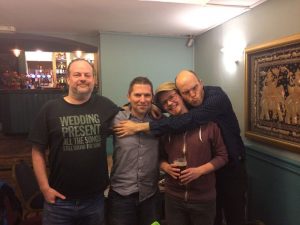
Chris (left) and David (second from left) with their fellow designers Rasmus Hervig and Trevor Benjamin at their local playtest pub in Cambridge.
Essen Spiel 2017
In mid-2017, I began a design diary on Board Game Geek for a game called “Soldiers in Postmen’s Uniforms”. The design is based on the battle for the Polish Post Office in the Free City of Danzig on the first day of WW2. Michał Ozon of PHALANX saw the design diary and asked me if we could meet in Essen during Spiel 2017. Of course I eagerly agreed. I had long been a fan of PHALANX’s designs, especially “1944: Race to the Rhine”. But I also saw an opportunity. PHALANX is a publisher that knows how to do Waros, and “Europe Divided” is a Waro. So when we set up the meeting for Spiel, I asked if it was ok if I also presented “Europe Divided”. Michał and the PHALANX crew agreed.
Spiel was a flurry of activity - it always is. Chris and I were both pitching games. Some were collaborations between us, some we designed with others, and some were solo designs. I lugged around the prototypes for both “Europe Divided” and “Soldiers in Postmen’s Uniforms” all day — and these are pretty big games — and PHALANX was the only publisher I planned to pitch the games to. This is a bit unusual. Typically, you pitch games to a variety of publishers, but PHALANX had requested “Soldiers in Postmen’s Uniforms” and I felt “Europe Divided” was too good a fit for them to pitch to anyone else. Chris and I met with Michał and Jaro Andruszkiewicz. Jaro and I hit it off immediately, sharing obscure stories of WW2 history, while Chris just looked on and chuckled at the military history nerds. Michał and Jaro gave us a verbal “yes” on the spot, and so the development of “Europe Divided” officially began.
[Chris: Pitching games can be a thankless task at the best of times, especially at Essen where everyone is under premium levels of stress – and usually getting little to no sleep! But sometimes you feel a warmth from early on that relaxes you, and this was one of those times. Even if we hadn’t come to an agreement on “Europe Divided”, I would have added PHALANX to my list of go-to publishers to pitch to in future. There was a great energy and enthusiasm, but also a clear level of professionalism and practicality.]
Let’s Make This Game Better…a Lot Better
As I said, Chris and I went into the meeting with PHALANX confident about the core of “Europe Divided”, and that core hasn’t changed. But Jaro, who took on the role of developer, pushed us hard to make improvements to the game. He wanted additional options in the game, and he especially wanted to improve the theming. Why didn’t the Baltic and Black Sea have special effects when a power held influence over them? Shouldn’t the action cards be able to do more than just basic actions?
Jaro lives in St Albans, not far from London, which made it possible for us to meet in person. He and I met for the better part of a day in Cambridge in December 2017. We went through all the revisions Chris and I worked on post-Essen. He was happy but kept pushing. We met again in St Albans in March 2018. More improvements, more work. But it was also at this meeting where Jaro and I were able to spend time together just chatting, becoming friends. The result was a closer designer-developer relationship, which “Europe Divided” has really benefited from. In the end, Jaro and the PHALANX crew pushed us to add special cards for the Black and Baltic Sea, to add actions and effects to some of the Russia cards and all of the cards for the contested countries, and to add additional headline cards. This ultimately added a ton of replay value, strategic depth, and improved theming.
[Chris: I think (especially first-time) designers can be a little too precious about their creations. If you want to succeed, the old writers’ adage ‘kill your darlings’ very much holds you may need to loosen up on sections of your design to make it publishable. This isn’t a problem David and I have and I think it works in our favor – we're keen to take on advice and amend designs accordingly. With Europe Divided, we went in with a very lean game that would probably have sold to a euro publisher – but as war game publisher, Phalanx could still see enough to build on. They wanted the chrome, where another publisher might not. To keep your options open, it pays dividends to be flexible.]
The Final Changes
The last major changes to the design came about a year ago, as I was moving from the UK to the US. We had finished working on the core design, and wanted to add two more elements: cards that would provide some special abilities to each power, but outside of the core action card and headline card structure, and we wanted to add future, hypothetical headlines.
The first of those elements - the special actions - are enabled through the addition of advantage cards. These cards represent thematic elements tied to western Europe and Russia that couldn’t be modeled by the action and headline cards. Each power has a deck of nine advantage cards, and players have the opportunity to use four over the course of the game. These cards model concepts such as European sanctions on Russia or Russia’s use of Maskirovka for their military operations.
The other late addition was the option of including future headlines. We wanted players to be able to ask questions like: “What would happen if Russia took the Baltics”, or “What happens if NATO deploys nuclear weapons in Poland”? Each of the headlines is inspired by events happening across Europe today.
In Closing…
After its long and winding road from a sketch of an idea in 2015 to a final product, we’re very proud of what Europe Divided has become. With Chris’ help and insight, I was able to transform a streamlined core design into a tense game with tons of player interaction. Our playtesters worked tirelessly to help us refine the design. And of course, Jaro and the PHALANX team pushed us beyond our comfort zone to make the final improvements. We hope you enjoy the game as much as we do!

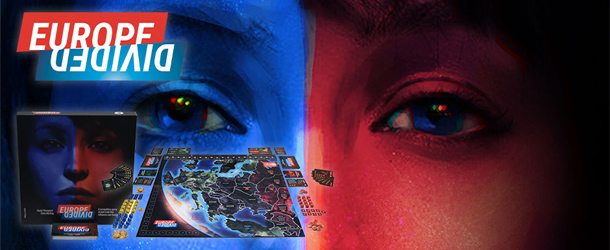
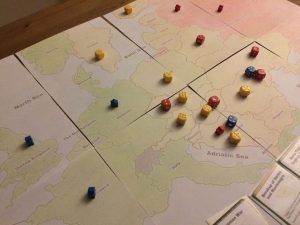
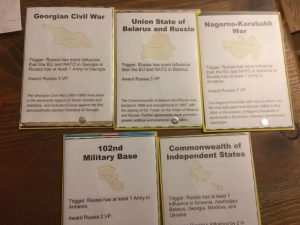
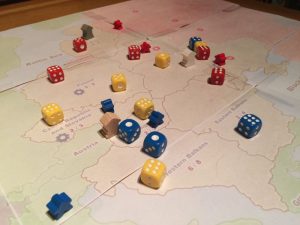
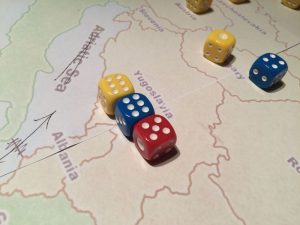
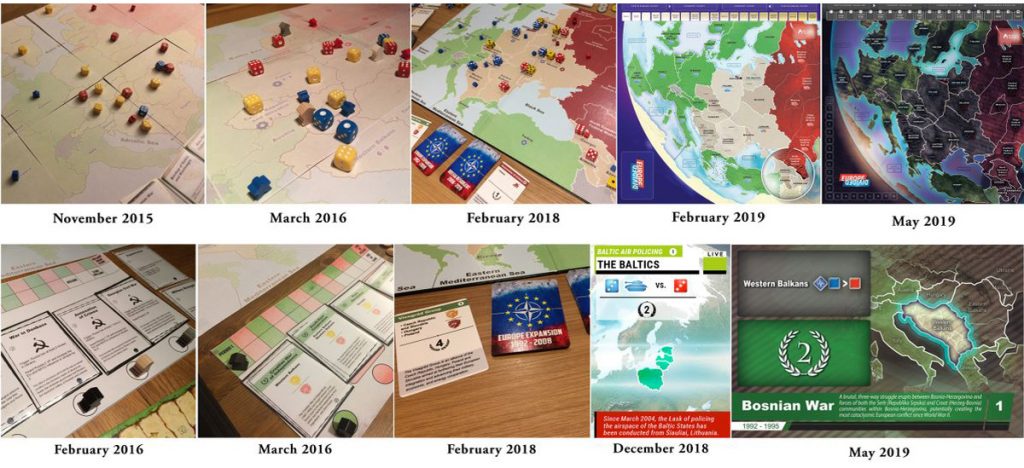


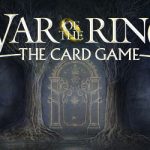





Follow Us on